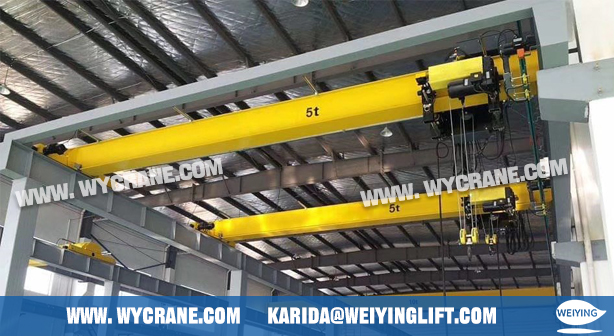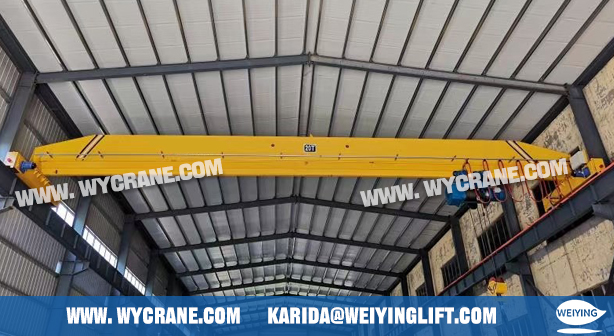Load swing is one of the most common and dangerous challenges in overhead crane operation. When a suspended load begins to swing, it can strike nearby structures, equipment, or workers — resulting in damaged materials, costly downtime, and serious safety incidents. According to industry safety reports, uncontrolled load swing accounts for a significant percentage of crane-related accidents each year.
To address this issue, modern overhead cranes are increasingly equipped with anti-swing (or sway control) technology. This intelligent system automatically suppresses load oscillation during lifting, traveling, and positioning, allowing for faster, safer, and more precise handling. For businesses in manufacturing, logistics, and heavy industry, adopting anti-swing technology means improving productivity by up to 40%, reducing training time for operators, and significantly extending equipment life.
 |
 |
Load swing occurs when the suspended load continues to move after the crane trolley or bridge changes speed or direction. This swinging motion is similar to a pendulum effect and is influenced by several factors:
If the load’s center of gravity is not properly aligned with the hoist hook, even small movements can trigger oscillation. Unbalanced loads increase stress on the hoist wire and make accurate positioning difficult.
Rapid starting or braking of the trolley or bridge amplifies the swinging motion. This often happens when operators are inexperienced or when cranes lack smooth control mechanisms.
Strong winds, uneven floor vibrations, or movement of nearby equipment can push a suspended load out of alignment, especially in large workshops or outdoor environments.
Untrained or fatigued operators may overcorrect load movement, causing additional swing instead of stopping it.
Worn-out brakes, gear misalignment, or inconsistent motor speeds can disrupt smooth operation and trigger load instability.
An anti-swing system (also called a sway control system) is a smart motion control solution designed to minimize or completely eliminate load swing during crane operation.
It uses advanced sensors, motion algorithms, and frequency control drives (VFDs) to adjust the crane’s movement in real time.
When the operator starts, stops, or changes direction, the system calculates the pendulum motion of the load and automatically compensates for it by controlling acceleration and deceleration rates.
In short, it synchronizes the crane’s motion with the natural oscillation of the load — neutralizing the swing before it becomes visible.
Modern anti-swing systems are fully integrated into the crane’s control unit, requiring no additional manual input from the operator. With just a standard joystick command, the system manages all dynamic corrections automatically, providing smooth and stable operation throughout the lifting cycle.
Anti-swing systems combine sensor feedback and mathematical algorithms to analyze load motion and apply counteractive force. The process typically involves four key steps:
Load Detection – Sensors measure the initial position and pendulum angle of the suspended load.
Motion Calculation – The system calculates how the load will behave based on acceleration, hoisting height, and direction.
Dynamic Adjustment – The control unit automatically fine-tunes the motor’s acceleration and braking curves to counteract the predicted swing.
Continuous Feedback – The system continuously monitors load movement and adjusts the crane’s speed to maintain stability.
As a result, even when the crane travels at higher speeds, the load remains nearly motionless, allowing for precise placement and faster workflow.
Implementing anti-swing technology offers measurable benefits across multiple aspects of crane operation — from safety to productivity and maintenance.
The most significant advantage is improved workplace safety. By minimizing load oscillation, the system prevents accidental collisions with workers, walls, or other cranes. It also reduces stress on the wire rope and hoist, extending the life of critical components.
With no need to manually wait for the load to stabilize, operators can complete lifting cycles much faster. In many industrial tests, cycle time reductions of up to 40% have been achieved. This allows higher throughput without compromising safety.
Traditional crane operation requires considerable skill to manually control load swing, which can be stressful and time-consuming. Anti-swing systems simplify control, allowing new operators to perform precise lifts with minimal training.
Because the system automatically stabilizes the load, placement accuracy is greatly improved — often within a few centimeters. This is especially important for assembly lines, mold handling, or precision manufacturing.
Smooth acceleration and braking reduce mechanical shocks to motors, brakes, and gearboxes. Over time, this leads to fewer breakdowns and longer service life for the crane and its components.
Anti-swing technology is highly versatile and can be integrated into overhead cranes, gantry cranes, and jib cranes used in various industries:
Manufacturing: For assembly lines, machine loading, and precision component placement.
Steel and Metallurgy: For moving large molten ladles or steel plates safely.
Ports and Logistics: For container handling, where stability and speed are crucial.
Power Plants: For turbine, generator, and maintenance lifting operations.
Warehouses and Workshops: For fast and efficient material transfer.
Regardless of the industry, the goal is the same — safe, smooth, and efficient material handling.
For modern industries aiming to increase productivity without compromising safety, anti-swing technology is no longer a luxury — it is a necessity. The combination of intelligent control and mechanical precision delivers tangible advantages:
Fewer accidents and insurance claims
Shorter downtime and maintenance costs
Improved operator performance and retention
Higher operational efficiency and return on investment
As automation and digitalization continue to shape industrial lifting equipment, anti-swing systems represent a major step toward smart crane operation.
Load swing has always been a major safety concern in overhead crane operations, but modern technology has made it controllable — even preventable.
By adopting anti-swing technology, companies can significantly reduce accidents, speed up operations, and ensure more precise load handling.
With 34 years of manufacturing experience and 12 years of export expertise, we have built a dual advantage of professional qualifications and a global presence. Our business covers more than 100 countries and regions across Asia, Europe, the Americas, Africa, and Oceania. We are certified under the ISO management system and hold CE product certifications. Our main product lines include six major series—electric hoists, electric winches, gantry cranes, bridge cranes, marine cranes, and portal cranes—comprising nearly 100 different models.
If you want to learn more, please contact us.
E-mail address: karida@weiyinglift.com
Website: www.wycrane.com